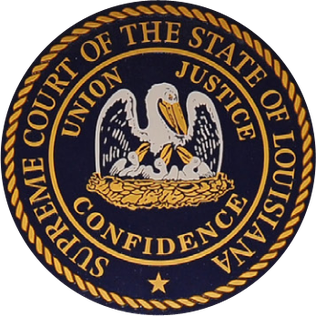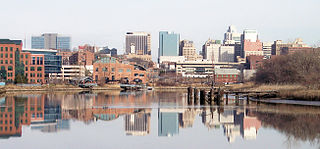The judiciary is the system of courts that interprets and applies the law in the name of the state. The judiciary can also be thought of as the mechanism for the resolution of disputes. Under the doctrine of the separation of powers, the judiciary generally does not make statutory law or enforce law, but rather interprets law and applies it to the facts of each case. However, in some countries the judiciary does make common law, setting precedent for other courts to follow. This branch of the state is often tasked with ensuring equal justice under law.

The United States courts of appeals or circuit courts are the intermediate appellate courts of the United States federal court system. A court of appeals decides appeals from the district courts within its federal judicial circuit, and in some instances from other designated federal courts and administrative agencies.

The Supreme Court of India is the highest judicial forum and final court of appeal under the Constitution of India, the highest constitutional court, with the power of judicial review. Consisting of the Chief Justice of India and a maximum of 31 judges, it has extensive powers in the form of original, appellate and advisory jurisdictions.

The Court of Appeals of Maryland is the supreme court of the U.S. state of Maryland. The court, which is composed of one chief judge and six associate judges, meets in the Robert C. Murphy Courts of Appeal Building in the state capital, Annapolis. The term of the Court begins the second Monday of September. The Court is unique among American courts in that the judges wear red robes. The Maryland Court of Appeals joins the New York Court of Appeals in being the only two state highest courts to bear the name "Court of Appeals" rather than "Supreme Court".

The Supreme Court of the Philippines is the highest court in the Philippines. It is presided over by a Chief Justice and is composed of fifteen (15) Justices, including the Chief Justice. Pursuant to the Constitution, the Supreme Court has "administrative supervision over all courts and the personnel thereof".

The federal judiciary of the United States is one of the three branches of the federal government of the United States organized under the United States Constitution and laws of the federal government. Article III of the Constitution requires the establishment of a Supreme Court and permits the Congress to create other federal courts, and place limitations on their jurisdiction. Article III federal judges are appointed by the President with the consent of the Senate to serve until they resign, are impeached and convicted, retire, or die.

The Supreme Court of Oklahoma is one of the two highest judicial bodies in the U.S. state of Oklahoma and leads the judiciary of Oklahoma, the judicial branch of the government of Oklahoma.

The Supreme Court of Bangladesh is the highest court of law in Bangladesh. It is composed of the High Court Division and the Appellate Division, and was created by Part VI Chapter I of the Constitution of Bangladesh adopted in 1972. This is also the office of the Chief Justice, Appellate Division Justices, and High Court Division Justices of Bangladesh. As of February 2019 there are 7 Justices in Appellate Division and 92 in High Court Division.

The judiciary of Pakistan is a hierarchical system with two classes of courts: the superior judiciary and the subordinate judiciary. The superior judiciary is composed of the Supreme Court of Pakistan, the Federal Shariat Court and five High Courts, with the Supreme Court at the apex. There is a High Court for each of the four provinces as well as a High Court for the Islamabad Capital Territory. The Constitution of Pakistan entrusts the superior judiciary with the obligation to preserve, protect and defend the constitution. Neither the Supreme Court nor a High Court may exercise jurisdiction in relation to Tribal Areas, except otherwise provided for. The disputed regions of Azad Kashmir and Gilgit–Baltistan have separate court systems.

The Oklahoma Court on the Judiciary is one of the two independent courts in the Oklahoma judiciary and has exclusive jurisdiction in adjudicating discipline and hearing cases involving the removal of a judge from office, excluding the Oklahoma Supreme Court, exercising judicial power under the Oklahoma Constitution.

The Supreme Court of Louisiana is the highest court and court of last resort in the U.S. state of Louisiana. The modern Supreme Court, composed of seven justices, meets in the French Quarter of New Orleans.
Mustafa Kamal was the 10th Chief Justice of Bangladesh. His landmark judgment was on the Masdar Hossain case, widely known as the ‘separation of judiciary', which was a milestone in the quest for separation of power between the judiciary and the executive of the state. Kamal was a pioneer of Alternative Dispute Resolution (ADR) in Bangladesh, and is considered by many as the 'father of ADR' in Bangladesh.
The Indian Judiciary administers a common law system of legal jurisdiction, in which customs, precedents and legislation, all codify the law of the land. It has in fact, inherited the legacy of the legal system established by the then colonial powers and the princely states since the mid-19th century, and has partly retained characteristics of practices from the ancient and medieval times.
Bangladesh is part of the common law jurisdiction. It is a member of the Commonwealth of Nations. The legal system of Bangladesh has its roots in the laws of British India. Since independence in 1971, statutory law enacted by the Parliament of Bangladesh has been the primary form of legislation. Judge made law continues to be significant in areas such as constitutional law. Unlike in other common law countries, the Supreme Court of Bangladesh has the power to not only interpret laws made by the parliament, but to also declare them null and void and to enforce fundamental rights of the citizens. The Bangladesh Code includes a compilation of all laws since 1836. The vast majority of Bangladeshi laws are in English. But most laws adopted after 1987 are in Bengali. Family law is intertwined with religious law. Bangladesh has significant international law obligations.
The Judiciary of Vermont is the state court system of Vermont, charged with Vermont law.

The Judiciary of Louisiana is defined under the Constitution and law of Louisiana and is composed of the Louisiana Supreme Court, the Louisiana Circuit Courts of Appeal, the District Courts, the Justice of the Peace Courts, the Mayor's Courts, the City Courts, and the Parish Courts. The Chief Justice of the Louisiana Supreme Court is the chief administrator of the judiciary, and its administration is aided by the Judiciary Commission of Louisiana, the Louisiana Attorney Disciplinary Board, and the Judicial Council of the Supreme Court of Louisiana.
The Judiciary of Illinois is the unified court system of Illinois responsible for applying the Constitution and law of Illinois. It consists of the Supreme Court, Appellate Court, and circuit courts. The Supreme Court oversees the administration of the court system.

The Judiciary of Bangladesh or Judicial system of Bangladesh is based on the Constitution and the laws are enacted by the legislature and interpreted by the higher courts. Bangladesh Supreme Court is the highest court of Bangladesh. The jurisdiction of the Supreme Court of Bangladesh has been described in Article 94(1) of the Constitution of Bangladesh. It consists of two divisions, the High Court Division and the Appellate Division. These two divisions of the Supreme Court have separate jurisdictions.
The term judicial review is not expressly used in Bangladeshi law, but Article 102 of the Constitution of Bangladesh allows writ petitions to be filed at the High Court Division for reviewing the actions of public authorities, or suspending proceedings in lower courts. The article has caused significant judicial activism in Bangladesh. In the 1970s, Article 102 was employed by the courts to set a precedent for invalidating detentions under the Special Powers Act. The courts have struck down constitutional amendments and enforced democratic local government under Article 102. The scope of such judicial review has expanded greatly since Justice Mustafa Kamal formally accepted public interest litigation for the first time in 1996, allowing associations and NGOs espousing the public's cause to file for judicial review.














